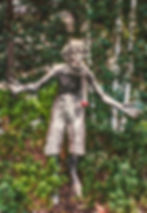

In “The Lightning Thief” by Rick Riordan, Percy has a Satyr best friend named Grover Underwood. Descriptions of the Satyr in Riordan's novel mention his curly reddish-brown hair, his fur covered body, his acne, and his wispy goatee beard. As Grover ages, his horns and goat-like legs grow larger, forcing him to take greater precautions to conceal them.
There are also disguised Satyr characters in Stephen King’s The Lawnmower Man and also The Lion, the Witch and the Wardrobe by C.S. Lewis.
But what exactly is a Satyr? Do Satyrs really exist?
According to Greek mythology, the SATYR was a male nature spirit with large ears, a tail, and a persistent erection.
Satyrs were often depicted naked and known for their alleged promiscuity, their love of wine, enjoyment of music & dancing, and their pursuit of women, which often resulted in them being depicted in art as sleazy philanderers.
Satyrs were often depicted in art as sleazy philanderers!
It was rumoured these creatures haunted secluded places such as dark forests, lonely hills, and barren fields and were constantly seeking to assault or tempt nymphs (though they usually failed).
Satyrs evolved to become portrayed as more human-like and less beastly over time, but these wild creatures still engaged in playful activities with nymphs. As they grew further domesticated and shed their most savage demeanour, they became well-known figures in children’s fantasy stories, commonly referred to as the less frightening version of the same creature, fauns.
It’s worth noting the similarity between classic Greek Satyrs and the folkloric “Old Man of the Forest” Silenus, as well as the different (though similar) English Green Man image.

In the Hebrew Bible, there are several references to SE’IRIM —creatures that resemble SATYRS— and these have a hairy goat-like appearance. In Hebrew, SA’IR translates to HE-GOAT in the singular form.
For example, Isaiah 13:21 predicts: “wild animals [ziim] will lie down there, and its houses will be full of howling creatures [ohim]; ostriches will live there, and goat-demons [sa’ir] will dance...”
Later early-Christian writers may have started-out depicting Satyrs as the same Biblical dark, evil, and demonic creatures, but their original Satyrs were probably legends of conquered wild-men (like Gauls and Celts).
In his poem The Faerie Queene, Edmund Spenser portrayed Satyrs as helpful creatures...
In his poem The Faerie Queene, Edmund Spenser portrayed Satyrs as helpful creatures, with a SATYRANE (half man half satyr) becoming tamed by the heroine figure depicted as UNA.
The Fisherville neighbourhood in Louisville, Kentucky, is known for various urban legends surrounding the POPE LICK MONSTER.
Although some claim the monster is the ghost of a circus freak who vowed revenge after being mistreated, it sounds very much as if the POPE LICK MONSTER is actually a modern-day SATYR. This monster apparently lures his victims onto the rail tracks where they die.
The Goatman of Maryland, with less evidence, also appears to be a creature equivalent to a SATYR, with the body of a goat and the upper body of a human.
Photos: © K. Mitch Hodge Words: © Neil Mach
The fantologist writer Neil Mach is highly regarded in the field of fantasy studies and has authored So You Want to Write Fantasy? The book is a fascinating manual that delves into fantasy perspectives.





